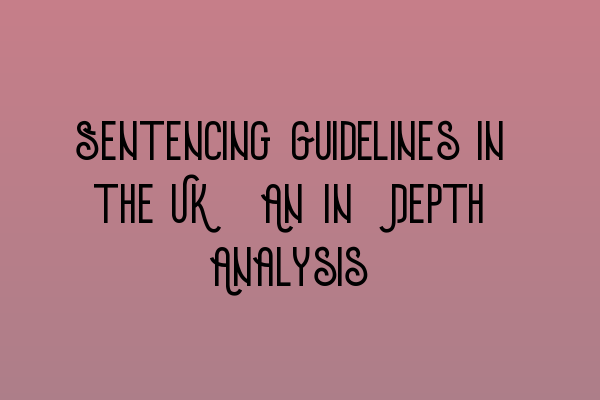Sentencing Guidelines in the UK: An In-Depth Analysis
Welcome to the SQE Criminal Law & Practice Law UK blog, where we provide comprehensive insights into various aspects of criminal law. In this blog post, we will delve deep into the topic of sentencing guidelines in the UK.
Sentencing guidelines play a crucial role in the criminal justice system as they provide judges with frameworks to determine appropriate sentences for different offenses. These guidelines ensure consistency and fairness by offering clear guidance to judges while taking into account various factors such as the seriousness of the offense, mitigating and aggravating circumstances, and the offender’s culpability.
Understanding the intricacies of sentencing guidelines is vital for legal professionals and aspiring solicitors preparing for the SQE exams. Knowledge in this area will help you navigate the complexities of sentencing and offer sound advice to your clients.
The Role of Sentencing Guidelines
Sentencing guidelines act as roadmaps for judges, guiding them in their decision-making process. They provide a structured approach, ensuring that similar offenses receive similar sentences and preventing sentencing disparities.
These guidelines enable judges to consider relevant factors and assess the appropriate level of punishment for each case, considering factors such as the harm caused, the offender’s level of involvement, any previous convictions, and any mitigating or aggravating circumstances.
It is important to note that sentencing guidelines are not mandatory, but rather advisory. Judges have discretion to deviate from the guidelines if they deem it necessary, but they must provide justifications for doing so.
Key Features of Sentencing Guidelines
Sentencing guidelines are developed by the Sentencing Council, an independent body that ensures consistent and transparent sentencing practices. These guidelines are formulated through extensive research, public consultation, and input from legal professionals.
The key features of sentencing guidelines include:
- Offense Categories: Sentencing guidelines classify offenses into specific categories based on their seriousness. These categories provide a starting point for judges.
- Sentencing Ranges: The guidelines provide a range of sentences for each offense category. Judges consider relevant factors and select an appropriate sentence within this range. The ranges include both custodial and non-custodial options.
- Mitigating and Aggravating Factors: The guidelines outline factors that may reduce or increase the severity of the sentence. These factors help judges ensure fairness and proportionality in sentencing.
- Previous Convictions: The guidelines consider an offender’s previous convictions as an aggravating factor, leading to harsher sentences.
Preparing for the SQE Exams
As an aspiring solicitor, understanding sentencing guidelines is crucial for your SQE exam preparation. To excel in the SQE 1 exams, ensure you have a solid grasp of criminal law, including sentencing principles. Consider practicing with SQE 1 practice exam questions and SQE 1 practice mocks FLK1 FLK2 to familiarize yourself with the exam format and test your knowledge.
For a comprehensive SQE 2 preparation, explore our SQE 2 Preparation Courses. These courses are designed to equip you with the necessary skills and knowledge to navigate the practical aspects of criminal law, including sentencing.
Stay Updated with SRA SQE Exam Dates
To stay informed about the SRA SQE exam dates, visit our page dedicated to SRA SQE Exam Dates. It is essential to be aware of the exam schedule to plan your preparation effectively and ensure you meet all the requirements.
Thank you for reading this in-depth analysis of sentencing guidelines in the UK. Stay tuned to our SQE Criminal Law & Practice Law UK blog for more valuable insights and guidance.
